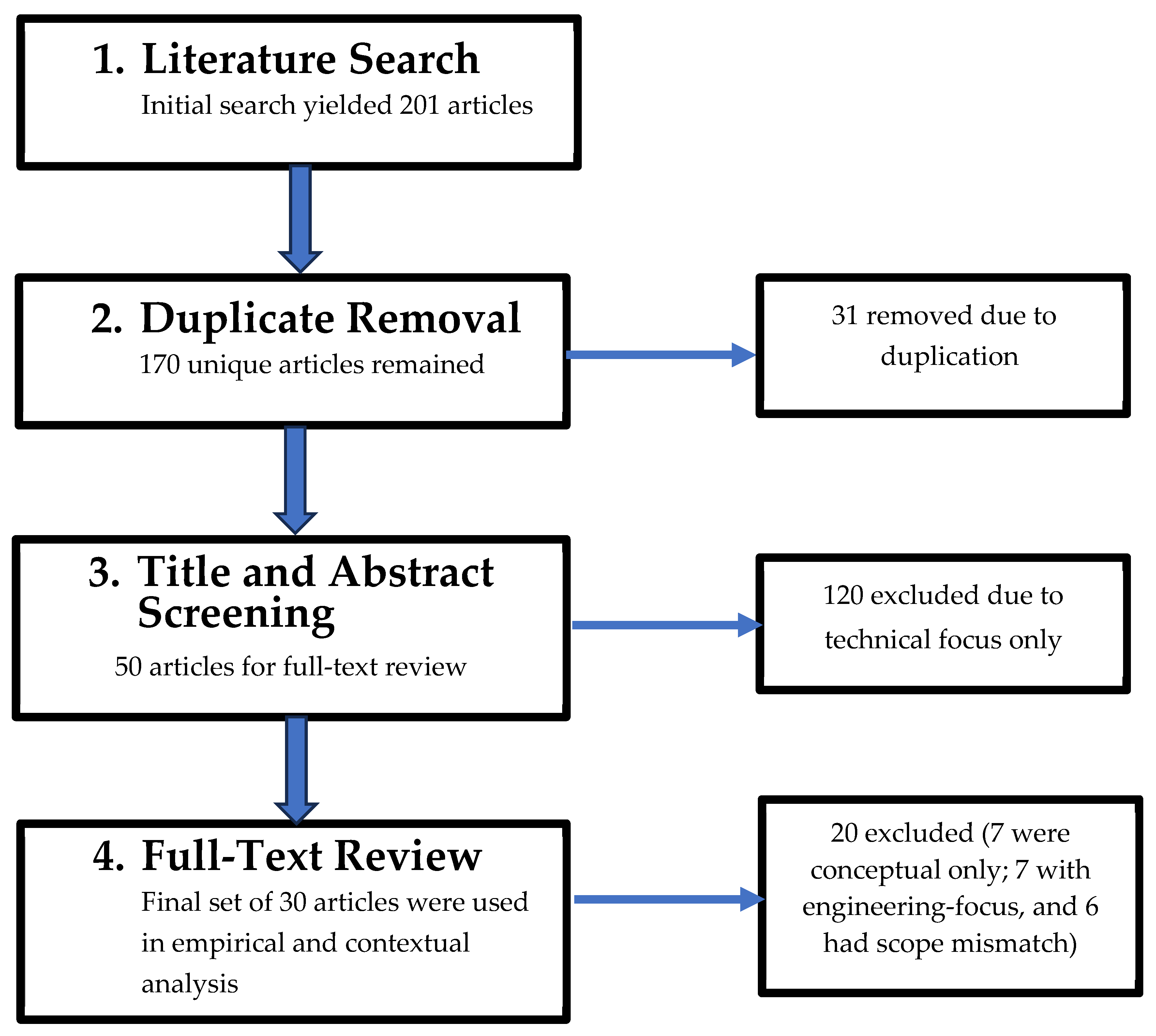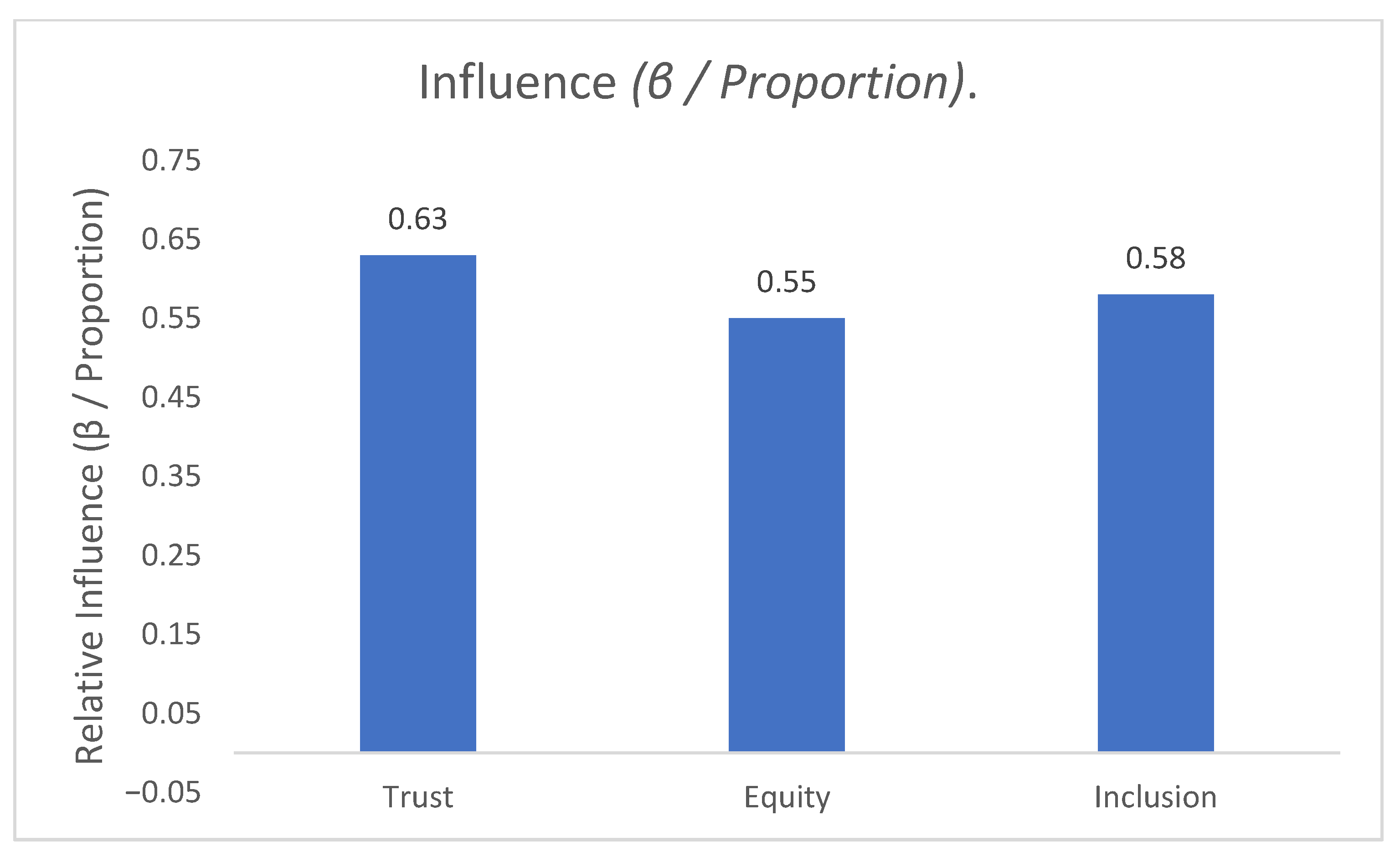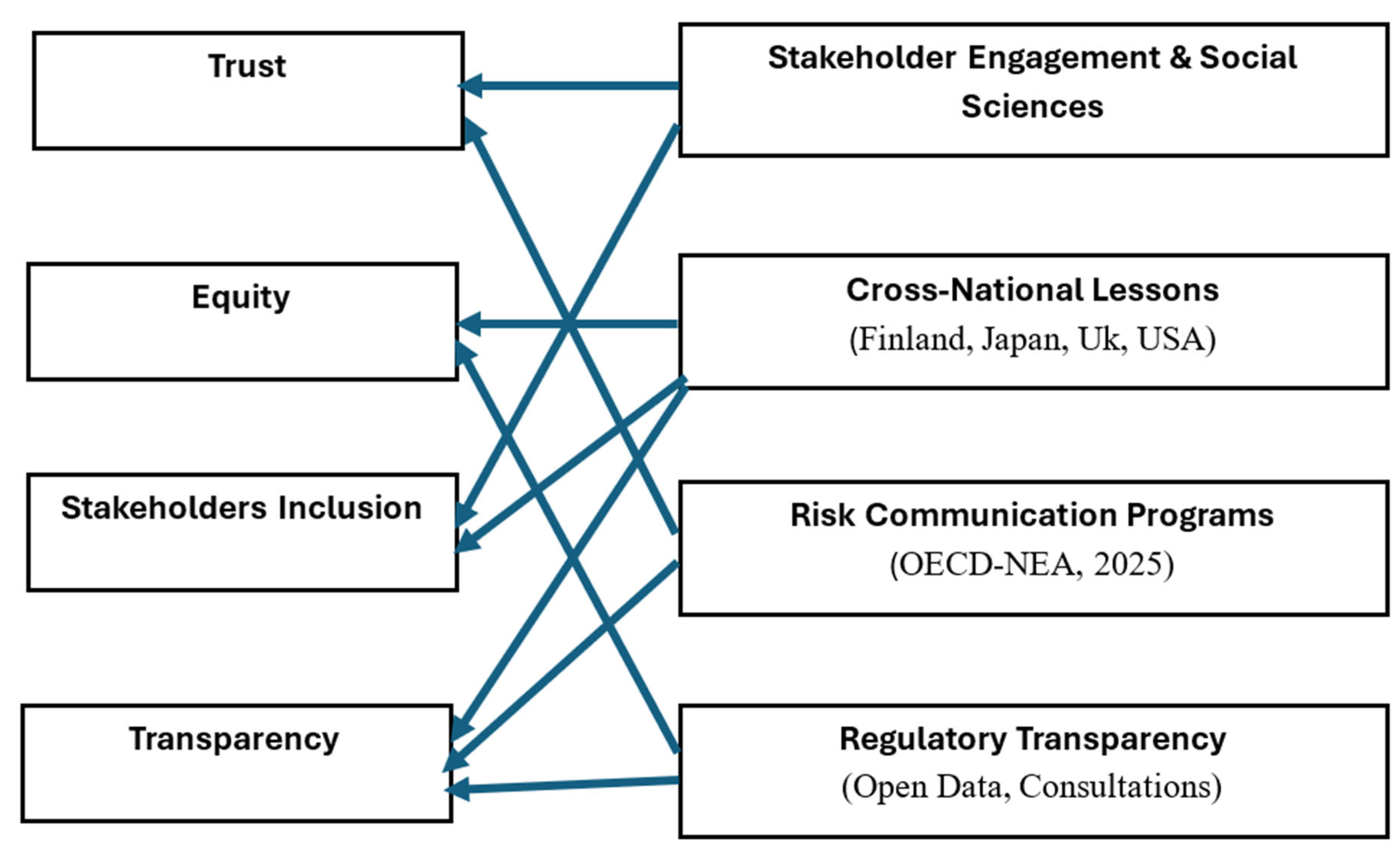Trust, Equity, Transparency and Inclusion in Nuclear Energy Governance: Empirical Synthesis of the Q-NPT Framework
Abstract
1. Introduction
2. Materials and Methods
2.1. Information Sources
2.2. Search Strategy
2.3. Inclusion and Exclusion Criteria
- Empirical evidence: Presented survey, experimental, participatory, or case study data on nuclear governance or analogous large-scale energy projects.
- Q-NPT relevance: Addressed at least one of the four Q-NPT principles (trust, equity, stakeholder inclusion, transparency).
- Contextual policy value: Provided authoritative policy guidance, institutional data, or conceptual framing essential for interpreting empirical results.
- Focused exclusively on technical/engineering analyses (e.g., reactor physics, design optimization) without governance or socio-political data.
- Were conceptual only without empirical or policy relevance to Q-NPT.
- Were duplicates, inaccessible full-texts, or non-English language.
2.4. Study Selection
2.5. Data Extraction
2.6. Synthesis Approach
- Transparent and independent regulation predicts public trust.
- Equitable distribution of risks and benefits correlates with community acceptance.
- Structured stakeholder inclusion improves governance outcomes.
3. Results
3.1. Proposition 1: Transparency and Independent Regulation as Predictors of Trust
3.2. Proposition 2: Equity and Fair Benefit Distribution as Drivers of Acceptance
3.3. Proposition 3: Stakeholder Inclusion and Governance Outcomes
3.4. Cross-Proposition Synthesis
4. Discussion
4.1. Global Policy Context
4.1.1. OECD-NEA High-Level Group on Stakeholder Engagement (HLG-SET)
4.1.2. Data Collection, Best Practices, and Cross-Country Learning
4.1.3. International Reports and Comparative Evidence
4.1.4. Risk Communication and Regulatory Transparency
4.1.5. Implications for Q-NPT
4.2. Extending Q-NPT to Emerging Technologies
- The three propositions (P1–P3) are validated across empirical cases and policy initiatives, but their effects are moderated by cultural and institutional factors.
- Q-NPT principles extend to emerging nuclear technologies, guiding transparent, equitable, and participatory governance.
- The framework provides normative direction and design constraints rather than universal rules, maintaining flexibility and practical relevance.
4.3. Operationalization and Theoretical Advancement of Q-NPT
5. Conclusions
Funding
Data Availability Statement
Conflicts of Interest
Appendix A. Addressing Potential Criticisms of Q-NPT
| Potential Criticism | Q-NPT Response |
|---|---|
| Undermines established norms: Promotes greater nuclear access for developing nations, potentially clashing with NPT objectives. | Q-NPT complements NPT safeguards by embedding trust, transparency, and verification. It promotes responsible, peaceful nuclear programs without bypassing global norms. |
| Creates “double standards”: Could be seen as preferential treatment for some nations. | Q-NPT is context-sensitive, not preferential. It provides capacity-building and equitable technology sharing to level the playing field and ensure fairness. |
| Potential for misuse: Looser access could increase military diversion risks. | Q-NPT incorporates multi-layered oversight, reporting, and stakeholder engagement. Empirical evidence shows trust and transparency reduce misuse incentives. |
| Challenges NPT authority: Offering an alternative governance model could weaken NPT legitimacy. | Q-NPT is complementary, not a replacement. It addresses governance gaps while reinforcing NPT principles through practical, transparent mechanisms. |
| Ambiguity in implementation: Questions about balancing energy needs with safety and IAEA oversight. | Q-NPT provides adaptable, evidence-informed pathways, supported by case studies, that balance energy expansion with global safety and oversight standards. |
References
- International Atomic Energy Agency. Nuclear Power Reactors in the World, 44th ed.; Reference Data Series No. 2; IAEA: Vienna, Austria, 2024; Available online: https://www.iaea.org/publications/15748/nuclear-power-reactors-in-the-world (accessed on 3 October 2025).
- Sovacool, B.K.; Gilbert, A.; Nugent, D. An international comparative assessment of construction cost overruns for electricity infrastructure. Energy Res. Soc. Sci. 2014, 3, 152–160. [Google Scholar] [CrossRef]
- Ramana, M.V. Nuclear power and the public. Soc. Stud. Sci. 2011, 41, 1–32. [Google Scholar] [CrossRef]
- Murakami, T.; Anbumozhi, V.; Kimura, K.; Iwata, T.; Yokota, E.; Yokota, T. Public Perception and Acceptance of Nuclear Power: Stakeholder Issues and Community Solutions; Economic Research Institute for ASEAN and East Asia: Jakarta, Indonesia, 2020; Available online: https://www.eria.org/publications/public-perception-and-acceptance-of-nuclear-power-stakeholder-issues-and-community-solutions (accessed on 5 August 2025).
- Saygın, M. Stakeholder perceptions and strategic governance of large-scale energy projects: A case study of Akkuyu Nuclear Power Plant in Türkiye. Sustainability 2025, 17, 7821. [Google Scholar] [CrossRef]
- Qudrat-Ullah, H. Advancing nuclear energy governance through strategic pathways for Q-NPT adoption. Energies 2025, 18, 4040. [Google Scholar] [CrossRef]
- Qudrat-Ullah, H. The Q-NPT: Redefining nuclear energy governance for sustainability. Energies 2025, 18, 4055. [Google Scholar] [CrossRef]
- Qudrat-Ullah, H. Global Peace Through Nuclear Energy Synergy: Balancing Collaboration and Security; Ethics Press: Cambridge, UK, 2025; Available online: https://ethicspress.com/products/global-peace-through-nuclear-energy-synergy (accessed on 7 March 2025).
- Baqi, A.; Abdeldayem, M.; Aldulaimi, S. Assessing the role of direct public engagement in shaping the UAE nuclear energy sustainability image. Int. J. Organ. Anal. 2023, 32, 1669–1688. [Google Scholar] [CrossRef]
- Turcanu, C.; Perko, T.; Laes, E. Public participation processes related to nuclear research installations: What are the driving factors behind participation intention? Public Underst. Sci. 2013, 23, 331–347. [Google Scholar] [CrossRef] [PubMed]
- Nuclear Energy Agency. NEA Mandates and Structures: NEA High-Level Group on Stakeholder Engagement, Trust, Transparency and Social Sciences (HLG-SET); OECD-NEA: Paris, France, 2023; Available online: https://www.oecd-nea.org/tools/mandates/index/id/12041/lang/en_gb (accessed on 27 September 2025).
- Nuclear Energy Agency. New NEA High-Level Group Will Tackle Stakeholder Engagement, Trust, Transparency and Social Sciences (HLG-SET); OECD-NEA: Paris, France, 2023; Available online: https://www.oecd-nea.org/jcms/pl_123456 (accessed on 27 September 2025).
- Nuclear Energy Agency. Strengthening the Relationship Between the Nuclear Sector and Civil Society: HLG-SET Programme of Work; OECD-NEA: Paris, France, 2024; Available online: https://www.oecd-nea.org/jcms/pl_93289/strengthening-the-relationship-between-the-nuclear-sector-and-civil-society (accessed on 27 September 2025).
- ECOSENS Project. Report Highlights Key Recommendations for Stakeholder Engagement in Nuclear Energy Governance. 2025. Available online: https://ecosens-project.eu/ecosens-report-highlights-key-recommendations-for-stakeholder-engagement-in-nuclear-energy-governance/?utm_source=chatgpt.com (accessed on 26 September 2025).
- Dixon-Woods, M.; Agarwal, S.; Jones, D.; Young, B.; Sutton, A. Synthesizing qualitative and quantitative evidence: A review of possible methods. J. Health Serv. Res. Policy 2005, 10, 45–53. [Google Scholar] [CrossRef] [PubMed]
- Johnston, M.P. Secondary data analysis: A method of which the time has come. In Proceedings of the Qualitative and Quantitative Methods in Libraries, Istanbul, Turkey, 27–30 May 2014; Volume 3, pp. 619–626. Available online: https://www.qqml-journal.net/index.php/qqml/article/view/169 (accessed on 23 January 2025).
- Ho, S.S.; Leong, A.D.; Looi, J.; Chen, L.; Pang, N.; Tandoc, E.C., Jr. Science literacy or value predisposition? A meta-analysis of factors predicting public perceptions of benefits, risks, and acceptance of nuclear energy. Environ. Commun. 2019, 13, 457–471. [Google Scholar] [CrossRef]
- Office for Nuclear Regulation (ONR). Key Regulatory Considerations for the Application of Blockchain Technology in the Nuclear Sector: ONR Innovation Hub; UK Government; Office for Nuclear Regulation: London, UK, 2023. Available online: https://www.onr.org.uk/our-expertise/innovation/key-regulatory-considerations-for-the-application-of-blockchain-technology-in-the-nuclear-sector (accessed on 22 September 2025).
- Norton Rose Fulbright. Applying Blockchain to the Nuclear Sector; Norton Rose Fulbright: Jardine House, Hong Kong, 2018; Available online: https://www.nortonrosefulbright.com/en-us/knowledge/publications/5f320cc5/applying-blockchain-to-the-nuclear-sector (accessed on 22 September 2025).
- Agyekum, E.B.; Tarawneh, B.; Rashid, F.L.; Kumar, P.; Odoi-Yorke, F.; Togun, H.; Mbasso, W.F.; Velkin, V.I. A systematic review of nuclear energy and public acceptance—A detailed analysis of evolution, emerging trends, and future research potentials. Energy Explor. Exploit. 2025, 43, 2276–2302. [Google Scholar] [CrossRef]
- Perko, T.; Martell, M.; Turcanu, C. Transparency and stakeholder engagement in nuclear or radiological emergency management. Radioprotection 2020, 55, S243–S248. [Google Scholar] [CrossRef]
- Alzahrani, F.; Tawfik, R.; Alnaim, L.A.; Elzaki, R.M. Public Acceptance and Willingness to Pay for Nuclear Energy in Saudi Arabia. Sustainability 2025, 17, 7917. [Google Scholar] [CrossRef]
- Kim, Y.; Kim, W.; Kim, M. An international comparative analysis of public acceptance of nuclear energy. Energy Policy 2014, 66, 475–483. [Google Scholar] [CrossRef]
- Wang, J.; Kim, S. Comparative analysis of public attitudes toward nuclear power energy across 27 European countries by applying the multilevel model. Sustainability 2018, 10, 1518. [Google Scholar] [CrossRef]
- Cambero Inda, D.; Marpu, A.; Rubio, G.; Haas, C.; Dhagat, P.; Verma, A. Integrating Public Perspectives in Microreactor Facility Design. arXiv 2025, arXiv:2509.08975. [Google Scholar] [CrossRef]
- Xu, Y.; Yu, W.; Wan, Y.; Zhang, Z. Review of blockchain-based approaches to spent fuel management in nuclear power plants. arXiv 2025, arXiv:2506.00677. [Google Scholar] [CrossRef]
- Myeong, S.; Lee, J.W.; Bae, J.; Cho, C.H. Multi-dimensional policy decision-making model based on the quantum probability: The case of Korea’s nuclear power plant policy. Humanit. Soc. Sci. Commun. 2025, 12, 911. [Google Scholar] [CrossRef]
- Amekawa, Y. High-level radioactive disposal policy in Japan: A sociological appraisal. Sustainability 2023, 15, 7732. [Google Scholar] [CrossRef]
- Seidl, R.; Drögemüller, C.; Krütli, P.; Walther, C. A transdisciplinary approach to nuclear waste management: Citizens’ working group in Germany. Ambio 2025, 54, 1234–1249. [Google Scholar] [CrossRef] [PubMed]
- Towers, L.; Cotton, M. Trust, justice, and expertise in nuclear waste management: A Q-methodology study. J. Risk Res. 2024, 27, 1456–1478. [Google Scholar] [CrossRef]



| Proposition | Study | Context | Sample | Key Quantitative Findings | Key Qualitative Insights |
|---|---|---|---|---|---|
| Trust | [20,21] | Global review (15+ countries) | – | Transparency and engagement are strongest predictors of legitimacy | Inclusion consistently viewed as essential |
| [22,23] | Saudi Arabia, nuclear acceptance | 612 | Willingness to pay increases with institutional reliability | Trust in oversight strengthens legitimacy | |
| [9,24] | UAE, nuclear perception | 318 | Engagement improved trust (β = 0.65, p < 0.001) | Safeguards and clear risk communication build confidence | |
| Equity | [22] | Saudi Arabia, nuclear acceptance | 612 | Fairness predicts willingness to pay | Perceived distributive justice enhances acceptance |
| [3,10] | EU nuclear research installations | 405 | Moral norms predict inclusion (β = 0.47, R2 = 0.48) | Fair inclusion of community values drives engagement | |
| [4,5] | Finland, Japan, UK, US | 1200 | Participatory areas: 75–80% positive safety vs. 55–60% without | Local economic benefits and fair inclusion increase acceptance | |
| Inclusion | [20,21] | Global review | – | Engagement consistently improves legitimacy | Cross-national convergence on inclusion |
| [9,24] | UAE, nuclear perception | 318 | Engagement improved perceived safety (β = 0.61, p < 0.001) | Local employment and voice in decisions increase trust | |
| [3,10] | EU nuclear research installations | 405 | Attitudes toward inclusion predict engagement (β = 0.53, p < 0.001) | Community inclusion valued intrinsically | |
| [4,5] | Finland, Japan, UK, US | 1200 | Structured inclusion yields stronger acceptance | Dialogue and shared decision-making increase legitimacy |
| Technology | Proposition Supported | Key Evidence | Governance Implications |
|---|---|---|---|
| Microreactors | P2 (Equity), P3 (Inclusion) | Participatory design workshops in Southeast Michigan show that standardized designs may conflict with community expectations regarding safety and local benefits [25] | Localized engagement and fair benefit-sharing are essential for social acceptance. |
| Blockchain-based governance | P1 (Transparency/Trust) | Applications in spent fuel management and supply chains increase traceability, accountability, and stakeholder confidence [25,26] | Improves trust in oversight but requires regulatory harmonization and institutional capacity. |
| Advanced modeling approaches (e.g., quantum probability frameworks) | P1 (Trust), P2 (Equity), P3 (Inclusion) | Quantum probability models illustrate uncertainty and multidimensional trade-offs in nuclear energy decisions [8,27] | Decision legitimacy depends on combining technical rigor with fairness, stakeholder input, and transparency. |
| Proposition | Dimension | Example Indicators |
|---|---|---|
| P1: Trust through transparency | Public confidence; regulatory openness |
|
| P2: Equity through fair distribution | Risk–benefit distribution; justice |
|
| P3: Inclusion through stakeholder inclusion | Engagement breadth and depth |
|
Disclaimer/Publisher’s Note: The statements, opinions and data contained in all publications are solely those of the individual author(s) and contributor(s) and not of MDPI and/or the editor(s). MDPI and/or the editor(s) disclaim responsibility for any injury to people or property resulting from any ideas, methods, instructions or products referred to in the content. |
© 2025 by the author. Licensee MDPI, Basel, Switzerland. This article is an open access article distributed under the terms and conditions of the Creative Commons Attribution (CC BY) license (https://creativecommons.org/licenses/by/4.0/).
Share and Cite
Qudrat-Ullah, H. Trust, Equity, Transparency and Inclusion in Nuclear Energy Governance: Empirical Synthesis of the Q-NPT Framework. Energies 2025, 18, 5423. https://doi.org/10.3390/en18205423
Qudrat-Ullah H. Trust, Equity, Transparency and Inclusion in Nuclear Energy Governance: Empirical Synthesis of the Q-NPT Framework. Energies. 2025; 18(20):5423. https://doi.org/10.3390/en18205423
Chicago/Turabian StyleQudrat-Ullah, Hassan. 2025. "Trust, Equity, Transparency and Inclusion in Nuclear Energy Governance: Empirical Synthesis of the Q-NPT Framework" Energies 18, no. 20: 5423. https://doi.org/10.3390/en18205423
APA StyleQudrat-Ullah, H. (2025). Trust, Equity, Transparency and Inclusion in Nuclear Energy Governance: Empirical Synthesis of the Q-NPT Framework. Energies, 18(20), 5423. https://doi.org/10.3390/en18205423






